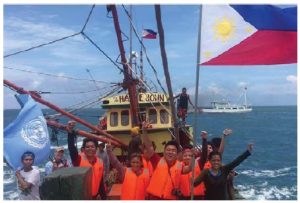
In July, the UN-backed Permanent Court of Arbitration in The Hague released a 500-page judgment on competing claims by the Philippines and China in the South China Sea. The court found that there is no legal basis for China’s historical claims to sea areas based on the “nine-dash line”; that none of the contested features is an “island” that can autonomously sustain human habitation and thus generate an exclusive economic zone; that China has violated the Philippines’ sovereignty by constructing artificial islands and by interfering with Philippine fishing and other activities; that China has severely harmed the coral reef environment, thus violating its obligation to protect fragile ecosystems; and, finally, that China’s actions since the beginning of arbitration have aggravated the dispute.
The ruling is final and binding under the United Nations Convention on the Law of the Sea (UNCLOS), of which China is a signatory member.
Chinese state interest in South China maritime resources began in 1909 when, in reaction to private Japanese extraction of guano from Pratas Island, the governor of Guangzhou sent an expedition to the Paracel Islands. In 1992, China unilaterally claimed a vast swath of the South China Sea by promulgating the Law on the Territorial Sea and the Contiguous Zone. Since 2009, China has advocated recognition of a U-shaped “nine-dash line” that carves out maritime areas far from China, but claimed by adjacent countries. In recent years, China has constructed military bases on coral reefs and rocks across the sea, with inevitable damage to marine ecosystems.
The Scarborough Shoal, known as Panatag Shoal by locals and Huangyan (Yellow Stone) Island by the Chinese, is approximately 220 kilometres from Luzon in the Philippines, but 1,200 kilometres from Hainan, China’s southernmost province. The Chinese first planted flags on Scarborough Shoal in 1997. In 2012, the Philippine navy intercepted Chinese fishing vessels, discovering that they had illegally collected corals, giant clams and live sharks. After a three-month standoff, the U.S. tried to broker an agreement. This was rejected by China, which subsequently blocked the Philippines’ access to the shoal. According to Jane’s Defence Weekly, Chinese plans for the Scarborough Shoal include an airfield and port that could make it another reclaimed island base such as Fiery Cross Reef, Subi Reef, Mischief Reef and Woody Island.

Local people have taken action to protect their interests. On June 12, Filipino youth activists from the organization Kalayaan Atin Ito (Freedom is Ours) planted Philippines and United Nations flags on the Scarborough Shoal to mark the Filipino National Day. Kalayaan Atin Ito has been vigilant about Chinese incursions into Filipino territory. Last December, they visited Pag-Asa (or Thitu) Island, which has been inhabited by Filipino civilians since the 1970s.
According to Kalayaan Atin Ito, the Chinese have intentionally poisoned sea life and destroyed coral reefs in efforts to eliminate the livelihoods of fishermen, with the goal of seizing and militarizing the island. The Permanent Court of Arbitration (PCA), relying on an independent report by three coral-reef ecologists, substantiated claims that China has illegally destroyed fragile maritime habitat.
The involvement of civilian social movements exerts pressure on the Philippines to enforce long-standing claims to sovereignty, especially now that they are upheld in the highest international tribunal for maritime disputes. President Rodrigo Duterte may take a stronger stand than president Benigno S. Aquino III, who, in 2014, equated China’s unilateral claim to the South China Sea to Hitler’s annexation of the Sudetenland. In what may be a sign of his intentions, he has already appointed Kalayaan Atin Ito leader Nicanor Faeldon as head of the Bureau of Customs.
China rejected the judgment entirely. Taiwan objected to being called “Taiwan Authority of China,” insisted that Taiping Island (under its control) is indeed an island, and also reiterated claims to the South China Sea as the Republic of China. Yet, Taiwan also stated that maritime disputes should “be settled peacefully through multilateral negotiations, in the spirit of setting aside differences and promoting joint development.” This demonstrates that the ROC is an independent player from Beijing, and could become part of a solution if accepted on the basis of equality with other independent states. It is ultimately in Taiwan’s best interests to embrace international law in the face of Chinese expansionism.
Responses to this ruling will shape the kind of world we live in. The United Nations was founded after the Second World War in order to promote peace based on international law, respect for equal rights and self-determination of peoples. UNCLOS and the PCA were intended to subject certain international disputes to neutral, third-party arbitration. Chinese militarization of the region, despite high ecological costs and destruction of local livelihoods, suggests that they have chosen the rule of force over the rule of law. The reaction of the world to this provocation will determine the course of the 21st Century.
Collateral Damage of ruling
The judgment made by the UN-backed tribunal in The Hague was aimed at stopping disruptive Chinese activities in Philippines territorial waters. Although China and Taiwan seemed united in voicing opposition to the arbitration, there are important differences in their approaches and in use of the South China Sea. If anything, Taiwan was also a victim of Republic of Philippines v. People’s Republic of China.
Whereas China has embarked on militarization of the region, Taiwan’s leaders have long been willing to set aside sovereignty disputes and seek pragmatic solutions. In 2015, Taiwan signed the “Agreement Concerning the Facilitation of Co-operation on Law Enforcement in Fisheries Matters” with the Philippines.
This was preceded in 2013 by an agreement between Taiwan and Japan about fishing in contested waters of the East China Sea.
Taiwanese authorities demonstrated their co-operative spirit by submitting documents to the UN tribunal, even while China negated the legitimacy of the proceedings. Taiwan’s contributions were supportive of China, since most Chinese claims and the idea of a dashed territorial line go back to the period from 1911 to 1949 when the Republic of China (ROC) was the sole government of all of China. Considering Taiwan’s will to assist international arbitration, it is an affront to diminish its status by calling it “Taiwan Authority of China.” This choice of vocabulary, intended to appease Beijing, ignores history and the continuing existence of the ROC since 1949.
Taiwan’s concern is that the ruling diminishes the status of Taiping Island/Itu Aba by declaring it a “rock.” Fully under ROC jurisdiction, the nearly 50-hectare island, with a natural freshwater spring, hosts coast guard units, a farm with livestock, a hospital, a Buddhist temple and facilities for sea rescue. Since 2007, the municipality of Kaohsiung has managed a turtle reserve there. Taiwan has plans to make the island into an important centre of scientific research on climate change. Taiwan’s peaceful and sustainable use of Taiping Island, especially in contrast to China’s belligerence and ecological destruction of other nearby maritime features, surely provides sufficient reason to welcome Taiwan as a full partner in the region.
— Scott Simon
Scott Simon is a professor at the School of Sociological and Anthropological Studies at the University of Ottawa.





